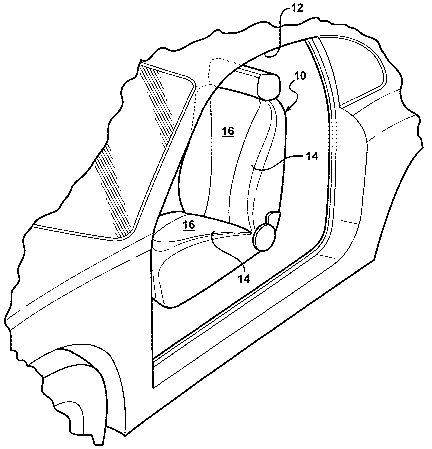Une partie des informations de ce site Web a été fournie par des sources externes. Le gouvernement du Canada n'assume aucune responsabilité concernant la précision, l'actualité ou la fiabilité des informations fournies par les sources externes. Les utilisateurs qui désirent employer cette information devraient consulter directement la source des informations. Le contenu fourni par les sources externes n'est pas assujetti aux exigences sur les langues officielles, la protection des renseignements personnels et l'accessibilité.
L'apparition de différences dans le texte et l'image des Revendications et de l'Abrégé dépend du moment auquel le document est publié. Les textes des Revendications et de l'Abrégé sont affichés :
| (12) Demande de brevet: | (11) CA 2547203 |
|---|---|
| (54) Titre français: | PROCEDE DE FIXATION DE GARNITURE |
| (54) Titre anglais: | TRIM ATTACHMENT PROCESS |
| Statut: | Réputée abandonnée et au-delà du délai pour le rétablissement - en attente de la réponse à l’avis de communication rejetée |
| (51) Classification internationale des brevets (CIB): |
|
|---|---|
| (72) Inventeurs : |
|
| (73) Titulaires : |
|
| (71) Demandeurs : |
|
| (74) Agent: | JEFFREY T. IMAIIMAI, JEFFREY T. |
| (74) Co-agent: | |
| (45) Délivré: | |
| (86) Date de dépôt PCT: | 2004-12-02 |
| (87) Mise à la disponibilité du public: | 2005-06-16 |
| Licence disponible: | S.O. |
| Cédé au domaine public: | S.O. |
| (25) Langue des documents déposés: | Anglais |
| Traité de coopération en matière de brevets (PCT): | Oui |
|---|---|
| (86) Numéro de la demande PCT: | PCT/CA2004/002065 |
| (87) Numéro de publication internationale PCT: | WO 2005053956 |
| (85) Entrée nationale: | 2006-05-25 |
| (30) Données de priorité de la demande: | ||||||
|---|---|---|---|---|---|---|
|
L'invention concerne un procédé de fixation d'une garniture en cuir sur un coussin de mousse au moyen d'un laminé. Le laminé comprend un film adhésif double face fixé à une surface supérieure et un adhésif activé par la chaleur appliqué sur une surface inférieure. Le procédé comprend les étapes consistant à placer la surface supérieure du laminé contre la garniture en cuir; à appliquer la surface inférieure du laminé sur le coussin de mousse; et à chauffer la surface inférieure du laminé afin de lier l'adhésif activé par la chaleur au coussin de mousse afin de le coupler à la garniture en cuir.
A method of attaching a leather trim cover to a foam pad utilizes a laminate.
The laminate includes a double-sided adhesive film secured to a top surface
and a heat-activated adhesive applied along a bottom surface. The method
includes the steps of placing the top surface of the laminate against the
leather trim cover; applying the bottom surface of the laminate to the foam
pad; and heating the bottom surface of the laminate to bond the heat-activated
adhesive to the foam pad and couple the leather trim cover thereto.
Note : Les revendications sont présentées dans la langue officielle dans laquelle elles ont été soumises.
Note : Les descriptions sont présentées dans la langue officielle dans laquelle elles ont été soumises.

2024-08-01 : Dans le cadre de la transition vers les Brevets de nouvelle génération (BNG), la base de données sur les brevets canadiens (BDBC) contient désormais un Historique d'événement plus détaillé, qui reproduit le Journal des événements de notre nouvelle solution interne.
Veuillez noter que les événements débutant par « Inactive : » se réfèrent à des événements qui ne sont plus utilisés dans notre nouvelle solution interne.
Pour une meilleure compréhension de l'état de la demande ou brevet qui figure sur cette page, la rubrique Mise en garde , et les descriptions de Brevet , Historique d'événement , Taxes périodiques et Historique des paiements devraient être consultées.
| Description | Date |
|---|---|
| Demande non rétablie avant l'échéance | 2010-12-02 |
| Le délai pour l'annulation est expiré | 2010-12-02 |
| Inactive : Abandon.-RE+surtaxe impayées-Corr envoyée | 2009-12-02 |
| Réputée abandonnée - omission de répondre à un avis sur les taxes pour le maintien en état | 2009-12-02 |
| Lettre envoyée | 2007-10-16 |
| Inactive : Transfert individuel | 2007-07-27 |
| Inactive : Page couverture publiée | 2006-08-30 |
| Inactive : CIB en 1re position | 2006-08-29 |
| Inactive : Lettre de courtoisie - Preuve | 2006-08-08 |
| Inactive : Notice - Entrée phase nat. - Pas de RE | 2006-08-03 |
| Demande reçue - PCT | 2006-06-17 |
| Exigences pour l'entrée dans la phase nationale - jugée conforme | 2006-05-25 |
| Demande publiée (accessible au public) | 2005-06-16 |
| Date d'abandonnement | Raison | Date de rétablissement |
|---|---|---|
| 2009-12-02 |
Le dernier paiement a été reçu le 2008-09-17
Avis : Si le paiement en totalité n'a pas été reçu au plus tard à la date indiquée, une taxe supplémentaire peut être imposée, soit une des taxes suivantes :
Veuillez vous référer à la page web des taxes sur les brevets de l'OPIC pour voir tous les montants actuels des taxes.
| Type de taxes | Anniversaire | Échéance | Date payée |
|---|---|---|---|
| Taxe nationale de base - générale | 2006-05-25 | ||
| TM (demande, 2e anniv.) - générale | 02 | 2006-12-04 | 2006-09-14 |
| Enregistrement d'un document | 2007-07-27 | ||
| TM (demande, 3e anniv.) - générale | 03 | 2007-12-03 | 2007-09-20 |
| TM (demande, 4e anniv.) - générale | 04 | 2008-12-02 | 2008-09-17 |
Les titulaires actuels et antérieures au dossier sont affichés en ordre alphabétique.
| Titulaires actuels au dossier |
|---|
| INTIER AUTOMOTIVE INC. |
| Titulaires antérieures au dossier |
|---|
| MARK JOSEPH MURPHY |